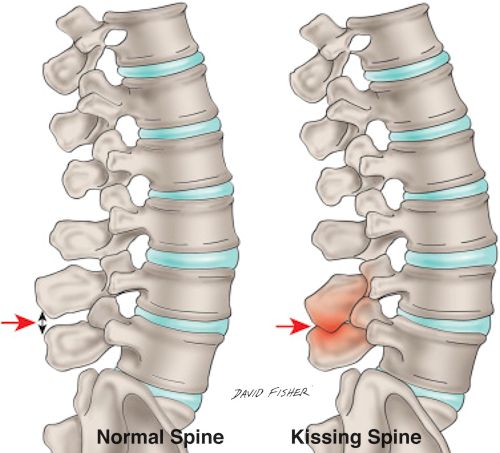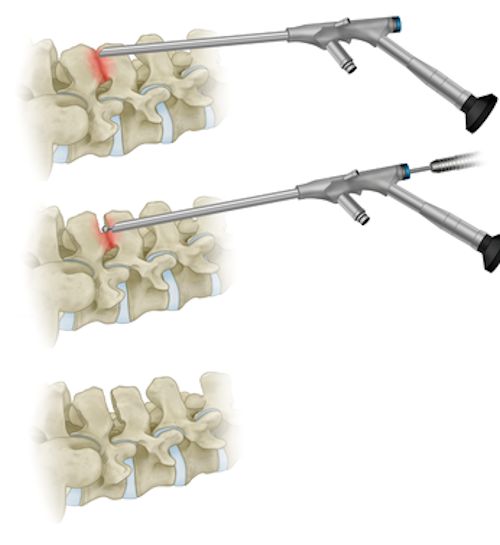Kissing Spine – Baastrup’s Disease
No, it is not a new type of therapy, kissing spine is a radiographic finding where the lumbar spinous processes are touching and can cause pain and limitation of motion.
A 2015 report in Insights Into Imaging indicates this is called Baastrup’s disease or kissing spines syndrome and is found with excessive lordosis and may produce mechanical pressure that causes repetitive strains of the interspinous ligament with subsequent degeneration and collapse. There is close approximation of spinous processes due to degenerative changes of the spine.

Baastrup’s disease usually affects the lumbar spine and L4/L5 is most commonly affected. Symptoms include back pain in the midline that is worse during extension (bending back), relieved during flexion (bending forward) and is provoked with finger pressure at the level(s). Subsequent findings including swelling, cystic lesions, sclerosis, flattening and enlargement of the articulating surfaces, bursitis and occasionally epidural cysts or midline epidural fibrotic masses.
It is a type of interspinous bursitis. Proposed therapies are conservative treatment like traction, injections or surgical therapies such as excision of the bursa or osteotomy.
A 2021 study in Orthopaedic Surgery used an endoscopic approach for chronic low back pain from Baastrup’s disease called interspinous plasty. After injecting an anesthetic to confirm the diagnosis, recovery of the gap between the spinous processes was performed by full-endoscopic resection of marginal osteophytes, removal of local inflamed tissue and reducing inflammation by intraoperative saline irrigation, which lead to pain relief.

Separation of the kissing spine was from 1 to 4 mm as confirmed by CT scans. The operations were performed under local anesthesia, with good clinical outcomes and a low incidence of complications or adverse events. The authors state, “This may be a feasible therapeutic method or an alternative option for patients who cannot tolerate general anesthesia surgery.”
A 2016 report in Case Reports Cureus found kissing spine or Baastrup’s disease is an often missed cause of back pain. A 56 year old man presented with chronic, ongoing low back pain of several years duration. Pain was relieved by flexion and aggravated by extension. Imaging studies revealed “kissing” spinous processes. He was treated with subcutaneous steroid injections and showed considerable clinical improvement.
As a similar finding for pain on extension, it may be mistaken for facet syndrome. Although, the two diagnoses may coexist. It is often found in association with central canal stenosis and disc bulging. MRI scans may show interspinous bursal fluid and can be helpful in determining if there is any associated spinal cord compression of the thecal sac.
A 2011 study in the American Journal of Roentgenology found Baastrup disease in 41% of patients with a peak of 81.3% among patients older than 80 years. As many as five levels were affected in some about 4% of patients and associated degenerative changes were found at almost all affected levels.
A 2008 study in the journal Spine notes lumbar interspinous bursitis (Baastrup disease) in a symptomatic population in age range from 7 to 89 years undergoing routine lumbar spine MRI found 8.2% (44 of 539) of the study population. There were associations between older age, central canal stenosis, disc bulging, and anterolisthesis (forward bone slippage). This indicates it is uncommon but not infrequent in symptomatic patients undergoing lumbar spine MRI.
In a 2021 study in Medicine (Baltimore), the authors described a new imaging finding called “Passing spine” without kissing, increasing the height and thickness of the lumbar vertebral spinous processes that can occur in individuals aged over 40 years. Comparing patients with kissing spine, patients with passing spine had an increased occurrence of lower extremity pain and lower disc height at the level of passing spine. Because the clinical and imaging characteristics of patients with passing spine are different from those of patients with kissing spine, passing spine might be a pathological condition distinct from kissing spine.
A 2021 study in the Journal of Neurosurgical Sciences concluded, “Baastrup disease is a common cause of low back pain. Proper diagnosis needs for imaging investigations and dynamic flexion-extension radiographs. Conservative and surgical therapies are available but there is a need for randomized clinical trials.”
In this study of 1308 patients, MRI was the most used form of imaging (56.2%), whereas flexion-extension radiographs only (16.2%). Anti-inflammatory drugs and therapy were chosen in 35.7% of cases, injections in 28.9% and surgical decompression in 70.7%.
A 2024 study in World Neurosurgery indicates kissing spine is relatively common in those with spinal degenerative diseases of the lower back, along with advanced age. Independent risk factors are severe disc degeneration and facet joint degeneration.
